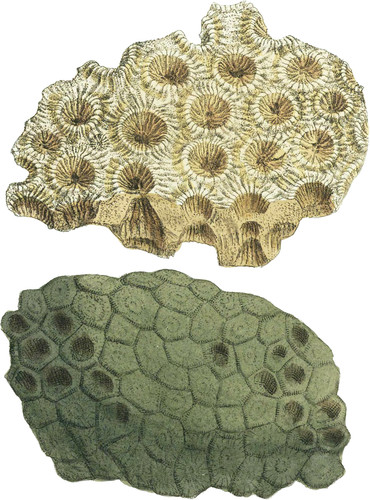 Enlarge
Enlarge
British Mineralogy
Coral-like Carbonate of Lime
- Div. 2. Imitative.
We read frequently with astonishment of vast Coral rocks in different regions of the globe, when it is only our negligence of the productions of our own country that makes us wonder, since every Limestone quarry and the adjacent places teem more or less with Corallines of various species, from Wiltshire to Yorkshire, Cumberland, &c., and even to Scotland and Ireland, Thus our island is almost all Coral rock externally, as will be shown, although some species are more local than others.
The specimen from which the upper figure is taken resembles Madrepora radiata of Solander and Ellis, tab. 47, fig. 8, but the artist seems to have forgotten the little intervening lamellated stellæ, or perhaps the specimen had not them. Gmelin and Solander do not mention any habitat. M. cavernosa of Espers Pflanzenthiere seems to belong to the same Coral. It has so exactly the appearance of a recent Coral, that it became quite necessary to show that it really was a mineral, in order that mineralogists may if possible be guarded in their conclusions, and examine further than the common external structure, however apparently decisive.
The organic appearance in this specimen is given by crystallized Carbonate of Lime, and is distinguished by its fracture, and in some parts we see the stalactitical form of infiltration, as it were, into the exquisite mould formed by nature around the animal remains of organization. I was favoured with this specimen by Charles Stokes, Esq. It was picked up in Wiltshire.
The specimen figured beneath is very like Madrepora ananas of Solander and Ellis, tab. 47, fig. 6, said by Gmelin to be found in the Mediterranean sea, and in America, and frequently fossil. It is nearly whole, having been bounded by a sort of shapeless rocks when formed by the animal inhabitants. This is, if possible, more perfect than the last; but its dingey appearance might give us reason at first to suspect it to be the remains of some old Coral, for it has very little of the appearance of Carbonated Lime, It was sent me from Kendal Fell in Westmoreland.
The laminæ of the nuclei are often curved in these specimens, and more irregular than in the spines of Echini, which, as in those figured tab. 151 and 152, have them universally as regular even in the minutest of their parts as in the metastatic crystal.

